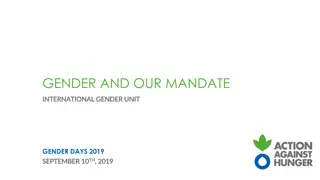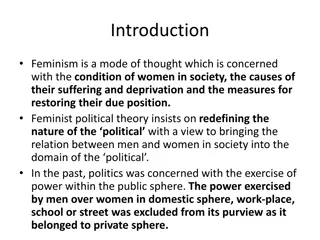Gender Equality and Policy Impact Analysis in Feminist Movements
This presentation delves into the correlation between the strength of autonomous feminist movements and various policy indicators related to gender equality and women empowerment. The study covers a range of factors such as CEDAW ratification, regional agreements, democracy levels, GDP per capita, and women representation in parliament. The coefficients analysis sheds light on the significant impact of feminist movements on policy outcomes, highlighting the importance of collective action for achieving gender equality.
Download Presentation

Please find below an Image/Link to download the presentation.
The content on the website is provided AS IS for your information and personal use only. It may not be sold, licensed, or shared on other websites without obtaining consent from the author. Download presentation by click this link. If you encounter any issues during the download, it is possible that the publisher has removed the file from their server.
E N D
Presentation Transcript
Appendix Extra Slides L Weldon HRFN 2018
Issue Name VAW Equality at Work Family Law Abortion Legality Leave Generosity RR Funding Issue-Type Status Status Doctrinal Doctrinal Class Class & Doctrinal Model Strong Autonomous Feminist Movement (lagged) SE Effective Women s Policy Machinery SE Democracy_level (Polity) 1 2 3 4 5 6 0.71 0.53 0.27 0.49 -0.37 1.21 0.12 0.18 0.12 0.06 0.14 0.23 0.72 -1.15 -0.25 0.15 -0.33 0.49 0.23 0.02 0.02 2.61 0.76 1.60 0.58 -1.27 0.63 1.50 0.69 -0.72 0.31 -0.16 0.36 0.06 0.35 -0.05 0.37 -0.11 0.43 0.26 0.04 0.02 1.31 0.42 1.04 0.23 0.53 0.18 0.25 0.32 -0.73 0.21 -0.06 0.19 0.40 0.19 -0.23 0.10 0.27 0.11 0.27 0.14 0.03 -0.74 0.28 0.16 0.16 1.48 0.20 -0.83 0.28 -0.38 0.15 0.18 0.20 0.79 0.21 -2.33 0.51 -0.94 0.52 0.40 0.06 0.05 1.07 0.44 0.01 0.42 3.52 0.22 -1.30 0.53 -1.11 0.25 -1.01 0.32 -0.73 0.32 0.63 0.44 -0.50 0.32 0.11 0.05 0.01 0.63 0.20 0.45 0.18 1.65 0.14 -0.87 0.11 0.29 0.12 0.43 0.15 0.09 0.17 0.74 0.15 -0.55 0.24 0.37 0.04 0.03 -1.85 0.56 0.48 0.33 1.04 0.33 -2.38 0.64 -0.34 0.20 -0.10 0.36 -0.73 0.19 -0.31 0.60 -1.30 0.64 SE GDP (logged) SE CEDAW Ratification (Lagged) SE Communist legacy SE Former Colony SE Official Religion SE Religiosity (Belief in God) SE Catholic majority SE Muslim majority SE Religious Party SE Left Party Strength (Cumulative) SE Women in Parliament (% lower house) SE N R2 0.01 0.00 0.01 0.00 0.01 0.00 0.00 0.00 0.00 0.00 0.00 0.00 0.03 0.04 0.07 0.08 0.02 0.07 0.01 198 .65 0.00 198 .66 0.01 198 .77 0.01 198 .57 0.01 198 .51 0.02 198 .38
TABLE 2: COEFFICIENTS (SE), LINEARCROSS-SECTIONALTIME-SERIES (PCSE) DV= VAW INDEX, 1975-2005 1 2 3 4 Model Strong &Autonomous Feminist Movement 0.61** (.20) 1.93*** (0.29) 0.65** (.20) 1.49*** (0.35) 0.57*** (.12) 0.40 (0.23) 0.07 (.15) 0.39 (0.21) -0.44* (0.19) 0.68** (0.22) Women s Policy Machinery CEDAW Ratify Interaction, SA Feminist Movement & CEDAW Ratify Withdraw Reservations 1.98** (0.62) 2.63*** (0.49) 2.08*** (0.58) 2.74*** (0.54) 0.63* (0.31) 0.73*** (0.22) 0.58*** (0.14) 0.04* (0.01) 0.39 (0.29) Regional Agreement 0.57** (0.18) 0.82*** (0.05) 0.03 (0.02) 0.38 (0.25) Regional Diffusion Democracy Level (Polity) 0.01 (0.03) 2.03** (0.70) 0.02 (0.03) 1.71** (0.60) 0.05*** (0.01) Logged GDP per capita Women in Parliament (%) Lagged VAW Index 0.38 (0.26) 195 .82 236 .62 252 .65 252 .82 N R2
Details of Indices: Abortion 10 = elective abortion in first and second trimesters 9 = elective abortion in 1rst trimester with no restrictions OR elective abortion in 1rst & 2nd trimester with some restrictions 8 = elective abortion in the first trimester, with some restrictions 5 = abortion permitted on soft grounds in addition to various hard grounds (including, at a minimum, rape and threat to the mother s life) 3 = abortion permitted when a woman has been raped in addition to other hard grounds (including, at a minimum, threat to the mother s life) 2 = abortion permitted for additional hard grounds (health, fetal abnormality, incest, but not rape) 1 = abortion permitted when mother s life is in danger (ONLY) 0 = abortion forbidden under all circumstances
Details of Index: Family Law MINIMUM MARRIAGE AGE CONSENT TO MARRY BAN ON MARRYING CERTAIN PEOPLE (E.G. NON-MUSLIMS) SPOUSAL RIGHTS AND OBLIGATIONS MARITAL NAME MARITAL PROPERTY REGIME GUARDIANSHIP/PARENTAL POWER INHERITANCE RIGHT TO WORK WITHOUT PERMISSION OF MALE RELATIVES RIGHT TO INITIATE DIVORCE CUSTODY OF CHILDREN AFTER DIVORCE DIVISION OF PROPERTY AFTER DIVORCE ADULTERY
Details of Indices: VAW 3 points for services to victims: (1 for each of the following): Government funds domestic violence Government funds rape crisis centres Government provides crisis services for other forms of violence (stalking, FGM, eve-teasing (street harassment), sati, etc) 3 points for legal reform (1 for each of the following): specialized legislation pertaining to domestic violence specialized legislation pertaining to sexual assault/ rape (i.e. rape shield laws) other forms of violence 1 point for policies or programmes targeted to vulnerable populations of women 1 point for training professionals 1 point for prevention programs 1 point for administrative reforms
List of Countries Algeria, Argentina, Australia, Austria, Bangladesh, Belgium, Botswana, Brazil, Bulgaria, Canada, Chile, China, Colombia, Costa Rica, Croatia, Cuba, Czech Republic, Denmark, Egypt, Estonia, Finland, France, Germany, Greece, Hungary, Iceland, India, Indonesia, Iran, Iraq, Ireland, Israel, Italy, Ivory Coast, Japan, Jordan, Kazakhstan, Kenya, Lithuania, Malaysia, Mexico, Morocco, Netherlands, New Zealand, Nigeria, Norway, Pakistan, Peru, Poland, Portugal, Romania, Russia, Saudi Arabia, Slovak Republic, Slovenia, South Africa, South Korea, Spain, Sweden, Switzerland, Taiwan, Tanzania, Thailand, Turkey, Ukraine, United Kingdom, United States, Uruguay, Venezuela, Vietnam
Figure I. Family Laws and Islamic Countries 14 12 10 Family Law Index 8 6 4 2 0 Non-Muslim Muslim Predominately Muslim Nation
Figure II. Family Laws and Religiosity 14 12 10 Family Law Index 8 6 4 2 0 0 20 40 60 80 100 Scale of Religiosity
Figure III. Family Laws and Religious Institutions 14 12 10 Family Law Index 8 6 4 2 0 0 5 10 15 20 Religious Insitutions Index
Figure 2. Adjusted Predictions of Family Law Index by Religious Legislation at Varying Levels of Religiosity
Figure I. Family Laws and Islamic Countries 14 12 10 Family Law Index 8 6 4 2 0 Non-Muslim Muslim Predominately Muslim Nation
Figure II. Family Laws and Religiosity 14 12 10 Family Law Index 8 6 4 2 0 0 20 40 60 80 100 Scale of Religiosity
Figure III. Family Laws and Religious Institutions 14 12 10 Family Law Index 8 6 4 2 0 0 5 10 15 20 Religious Insitutions Index


























